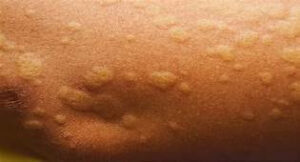September 12, 2019 | Black & Kletz Allergy

Hives are quite common as they affect 20% to 25% of the population at some point in their lives. Hives generally, as a rule, are intermittent and usually last less than 24 hours in duration. They may occur very frequently (i.e., multiple times per day) or they may occur very rarely (i.e., one isolated episode). If an episode of hives resolves within 6 weeks, it is known as “acute urticaria.” If the episode lasts more than 6 weeks in duration, it is known as “chronic urticaria.”
You may be asking yourself, what are the causes of hives, since they are so common. Many times, the cause is fairly obvious in such cases where the hives develop shortly after eating a certain food, or immediately after a bee sting. They may occur during the course of or shortly after completing a course of antibiotics. Other medications may be the causative agent in others affected with hives. Aspirin and nonsteroidal anti-inflammatory drugs (NSAID’s) are the most common classes of medications that cause hives besides antibiotics. Some of the most commonly prescribed NSAID’s include ibuprofen (Motrin, Advil), naproxen (Aleve, Naprosyn, Anaprox), salsalate (Disalcid), indomethacin (Indocin), etodolac (Lodine), diclofenac (Voltaren, Arthrotec, Cataflam), ketorolac (Toradol), piroxicam (Feldene), meloxicam (Mobic), Oxaprozin (Daypro), nabumetone (Relafen), tolmetin (Tolectin), fenoprofen (Asaid), sulindac (Clinoril), and celecoxib (Celebrex). It is important to note that any medication or food can cause hives in any individual, despite the fact that they may have ingested the food or medication in the past without reactions. An assortment of other conditions such as infections (viral, bacterial, fungal, or parasitic), inflammatory conditions, autoimmune disorders (when the immune system fights an individual’s own tissues and organs instead of defending them against outside intruders), and rarely even cancers can play a role in causing hives. If the hives persist longer than 24 hours and/or they leave residual marks on the skin, it may indicate inflammation of the small blood vessels, a condition known as “vasculitis.” Other factors that may cause or exacerbate hives may include exercise, cold, heat, vibration, pressure, sun exposure, and/or water, to name a few.
If you suffer from hives, it is important to see a board certified allergist such as the allergists at Black & Kletz Allergy. Our allergy specialists see numerous cases of hives and/or swelling episodes each week. We have over 5 decades of experience in the Washington, DC, Northern Virginia, and Maryland metropolitan area in diagnosing and treating hives. We see patients of all ages ranging from newborns to the elderly. At your first consultation with our allergists, a comprehensive history and physical examination will be performed. Depending upon your history and examination, diagnostic tests may include bloodwork, allergy skin testing, urinalysis, X-rays, and/or a skin biopsy.
Since histamine is the principal chemical that is responsible for the development of hives, most of the cases are responsive to medications that block the action of histamine on the skin. In some individuals, avoidance of a particular food or medication is all that is needed. For others, there are a variety of treatment options, some of which include antihistamines, leukotriene antagonists, histamine-2 blockers, corticosteroids, immune modulators, and “biologicals” [e.g., omalizumab (Xolair) injections] or various combinations of the aforementioned medications.
Black &Kletz Allergy has 3 convenient locations in the Washington, DC metro area. We have offices in Washington, DC, McLean, VA (Tysons Corner, VA), and Manassas, VA which all offer on-site parking. The Washington, DC and McLean, VA locations are Metro accessible and there is a free shuttle that runs between the McLean, VA office and the Spring Hill metro station on the silver line. Please call us to make an appointment or you can click Request an Appointment and we will reply within 24 hours by the next business day. The allergy specialists of Black & Kletz Allergy are eager to help you with your hives, swelling episodes, allergic rhinitis (i.e., hay fever), asthma, sinus conditions, and immunology needs. We are dedicated to providing excellent care to you as we have been doing in the Washington, DC metro area for more than 50 years.












